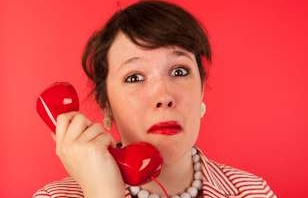A peek into a normal day with social anxiety:
 Because of social anxiety, Joan dreads going to the grocery. She especially dislikes having to pass people as she walks through the parking lot. She wonders what they see when they look at her. She hates the check out line. She feels like she’s on display as much as the food on the conveyor belt.
Because of social anxiety, Joan dreads going to the grocery. She especially dislikes having to pass people as she walks through the parking lot. She wonders what they see when they look at her. She hates the check out line. She feels like she’s on display as much as the food on the conveyor belt.
She smiles a lot. That’s because she has learned that if she smiles and turns her attention elsewhere, people will think she is normal and go about their business.
The gas station is no different from the grocery. Joan is self-conscious. She feels as if everyone is looking at her. Just walking into the gas station is hard. Standing in line is especially difficult.
Sometimes the self-conscious feelings are so intense that she wonders if she is crazy.
 On a good day she can speak to the people in line at the cash register; maybe even joke around a little. On a bad day she wishes she could shrink inside herself. Then, she avoids going out altogether.
On a good day she can speak to the people in line at the cash register; maybe even joke around a little. On a bad day she wishes she could shrink inside herself. Then, she avoids going out altogether.
Making a simple phone call, even to a good friend, requires a rehearsal. The longer she rehearses what she will say, the more nervous she becomes. Finally, she decides not to even make the call.
God forbid she be forced to speak in front of a group.
Social anxiety disorder is more than normal nervousness.
Butterflies in your stomach are normal if you are going to give a speech in front of your child’s class. When the butterflies turn into fear and self-consciousness, and sometimes panic, the symptoms of social anxiety are present.
Social anxiety disorder is a phobia in which a person has an excessive and unreasonable fear of social situations. Anxiety or intense nervousness and self-consciousness are produced by a fear of being watched, judged and criticized by others. The anxiety is so debilitating that it impacts daily life. Low self-esteem is common. When a trigger is encountered, the person may become panicked.
Physical social anxiety symptoms may include:
 • Elevated heart rate
• Elevated heart rate
• Upset stomach
• Dizziness
• Sweating
• Clammy palms
• Trembling
• Blushing
• Difficulty breathing
• Confusion (unable to focus)
• Muscle tension
• Diarrhea
According to the National Institute of Health, approximately 40 million adults in the United States suffer from social anxiety disorder.
 Social anxiety is what causes anxiety attacks in many cases. When a person with a social anxiety disorder is faced with being in a social setting that makes them uncomfortable, the feelings can bring on a panic attack. Social situations cannot always be avoided. When they become necessary, the symptoms of social anxiety take over. The person can feel as if they are losing control, or are going to die.
Social anxiety is what causes anxiety attacks in many cases. When a person with a social anxiety disorder is faced with being in a social setting that makes them uncomfortable, the feelings can bring on a panic attack. Social situations cannot always be avoided. When they become necessary, the symptoms of social anxiety take over. The person can feel as if they are losing control, or are going to die.
Hours are spent preparing for or examining daily tasks that most people perform easily.
A person with social anxiety may not be able to achieve career goals or enjoy a crowded event. It may be difficult to even use a public restroom. Saying a few words in front of a family gathering may cause full blown panic.
Social anxiety is also called social phobia. It can cause performance anxiety or stage fright.
Performance anxiety is experienced when a person is abnormally afraid to speak in front of people. Participating in an activity with other people can be equally as difficult.
People with social phobias want to do all of these things. They just are so overcome by their own thoughts and the reactions of their bodies that they become unable to function effectively. They cannot overcome their fears because their phobia is rooted within the unconscious mind.
Experts believe that the source of social anxiety is a problem with self-confidence. Self-confidence is a feeling of trust in one’s own abilities, qualities, and judgment. A person who lacks self confidence may worry excessively about what others think, or feel like things are always out of control.
The good news is that social anxiety symptoms can be brought under control easily and naturally.
Traditional treatments
Traditional treatments may include medications and therapy. But medications only mask the underlying causes. Therapy is rarely sought by someone who fears talking to a professional.
Ericksonian hypnotherapy and Neuro-Linguistic Programming techniques
 Ericksonian hypnotherapy and Neuro-Linguistic Programming techniques, when administered by an experienced professional, are the most effective phobia treatments. They work at the unconscious level of mind, which is where the phobia originates.
Ericksonian hypnotherapy and Neuro-Linguistic Programming techniques, when administered by an experienced professional, are the most effective phobia treatments. They work at the unconscious level of mind, which is where the phobia originates.
Hypnosis is a therapeutic modality that will help rid you of anxiety, which is what causes panic attacks. A good program will promote peace and boost confidence. Ideas are suggested within conversation and stories, to guide your mind toward positive thoughts which help eliminate social anxiety.
Neuro-Linguistic Programming, NLP is a fast and effective way to eradicate a phobia. It will remove your fears by targeting the thought process that creates the phobia.
A NLP technique called Visual/Kinesthetic Disassociation is often successful in just one session. It trains the client to mentally step outside themselves at the onset of an anxiety attack. It separates the feelings of anxiety from the mental images that trigger the social anxiety symptoms. This technique is successful for all phobias, not just social phobias.
Unfortunately, as effective as these techniques are, finding a local hypnotherapist who has the training and experience to guide you with them can prove daunting. And when you do finally find a qualified and Certified NLP Practitioner, the fees can be very steep.
 An alternative to expensive on-on-one therapy is to find a professionally created and produced recorded series of series hypnotherapy and NLP sessions. It’s best to thoroughly research the therapist who created the recordings, as all therapists and all recorded CD’s are not created equal!
An alternative to expensive on-on-one therapy is to find a professionally created and produced recorded series of series hypnotherapy and NLP sessions. It’s best to thoroughly research the therapist who created the recordings, as all therapists and all recorded CD’s are not created equal!
Many business people who are required to speak in front of small to large groups of employees have suffered from social anxiety and stage freight. However, after hypnotherapeutic intervention, most of these people go on to become great speech givers.
Case History:

Tina knows what causes panic attacks for her. She is a musician and has battled social anxiety all her life. Performance anxiety began to take root before she even got on stage.
Tina purchased the NLP and Hypnosis Audio program “I Am Fearless!“. She listened to it until her first musical performance. Tina reports, “I came through with flying colors and have not looked back.”
We are all born comfortable within ourselves and confident in our abilities. Sometimes, life programs us to think otherwise. “I Am Fearless!” is a hypnosis and NLP program that will help you eliminate all of your irrational fears. This program does not need to treat a panic disorder specifically. It will work to eliminate all phobias, including social anxiety disorder.

Alan B. Densky, CH specializes in stress and depression related symptoms as an NGH certified consulting hypnotist. He has helped thousands of clients since 1978. He offers panic attack treatment and phobia treatment CD’s. Visit his Neuro-VISION.us hypnosis website for the hypnosis programs, article library, and free videos on hypnosis.

